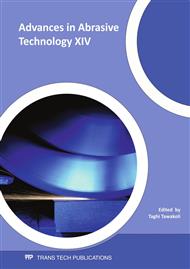p.517
p.523
p.530
p.536
p.542
p.548
p.557
p.563
p.570
Influence of Abrasive on Planarization Grinding Based on the Cluster Magnetorheological Effect
Abstract:
A new planarization grinding method based on the cluster magnetorheological (MR) effect is presented to grind optical glass in this paper. Some process experiments were conducted to reveal the influence of the species and granularity and content of the abrasive materials in the MR fluid on the machining effect, furthermore, the machining characteristic of grinded surface was studied. The results indicate that the abrasive influences definitively on machining effect of this planarization grinding method based on the cluster MR-effect. Under the certain experiment condition, with the content of the abrasive 10% and grain size 800# of SiC, best machining effect can be achieved. The difference species of abrasive results in various machining effects. As for the removal rate of K9 optical glass: abrasive CeO2 is the best, the Al2O3 is the second and the SiC is the worst. While the surface roughness: abrasive SiC is the lowest,the Al2O3 is the second and CeO2 is the highest.
Info:
Periodical:
Pages:
542-547
Citation:
Online since:
August 2011
Authors:
Keywords:
Price:
Сopyright:
© 2011 Trans Tech Publications Ltd. All Rights Reserved
Share:
Citation:


